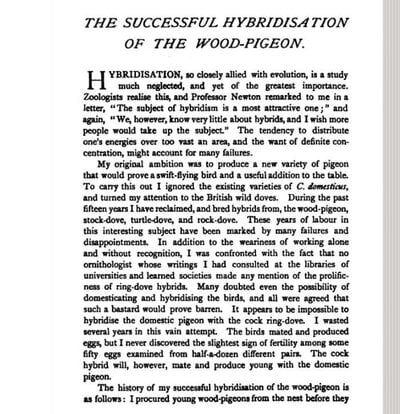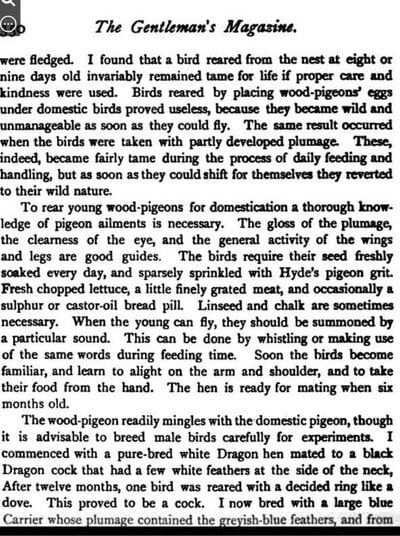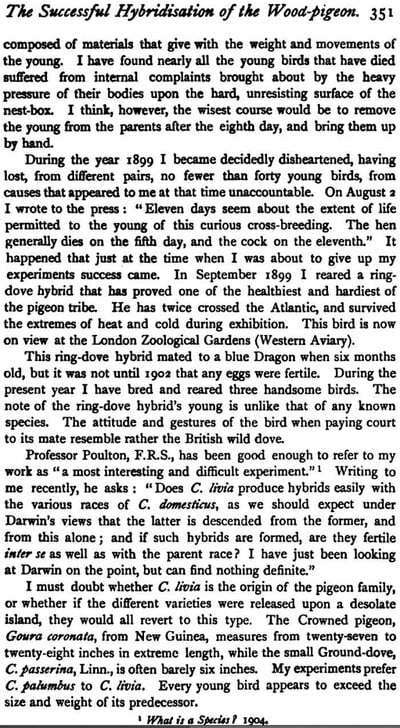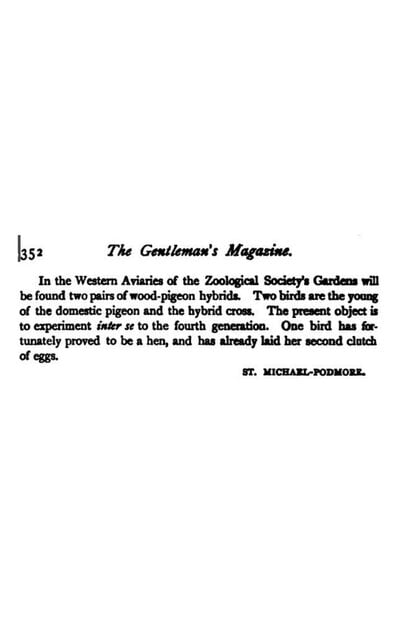Lamg
Chirping
- Apr 19, 2022
- 37
- 33
- 64
Many people in the past have considered creating a new breed of pigeon with a little "blood" from another related species. It is most tempting to create a massive pigeon with good flying skills, based on the homing pigeon and wood pigeon.
Interspecific breeding has indeed occurred in the past. A recent study found that the checkerboard pattern of the domestic pigeon was adopted through cross-breeding with the pigeon in the past. https://www.biorxiv.org/content/10.1101/242552v1.full
The Gazzy pattern split off and was fixed probably due to ancient crossing with the Snow Pigeon, with which it has fertile offspring due to close kinship.
Many chicken breeds owe their existence to the crossing of domesticated chickens with other 3 jungefowl species - gray factor, different comb forms, vocal expressions. It will probably be similar for pigeons, but further research is needed.
A fertile hybrid F1 male can be obtained by crossing a domesticated pigeon male x wood pigeon female. If it were the other way around, the offspring are never fertile.
Once you get such a fertile male, you can backcross back to a domestic pigeon and subsequent generations are 100% fertile, and you can create a new breed.
An article that mentions the fertility of offspring from the crossing of rock pigeon x wood pigeon.
http://www.macroevolution.net/gametes.html#.Uzan5eL05HA (Podmore)
The problem is that wood pigeon hybrids are extremely shy and can die from stress. Even the drive for winter migration is preserved in the first few generations.
Videos where hybrids can be seen, some show birds that are quarter woodie.
Known pigeon hybrids and their fertility:
http://www.exoticdove.com/IDS/Articles/hybrids.htm
Interspecific breeding has indeed occurred in the past. A recent study found that the checkerboard pattern of the domestic pigeon was adopted through cross-breeding with the pigeon in the past. https://www.biorxiv.org/content/10.1101/242552v1.full
The Gazzy pattern split off and was fixed probably due to ancient crossing with the Snow Pigeon, with which it has fertile offspring due to close kinship.
Many chicken breeds owe their existence to the crossing of domesticated chickens with other 3 jungefowl species - gray factor, different comb forms, vocal expressions. It will probably be similar for pigeons, but further research is needed.
A fertile hybrid F1 male can be obtained by crossing a domesticated pigeon male x wood pigeon female. If it were the other way around, the offspring are never fertile.
Once you get such a fertile male, you can backcross back to a domestic pigeon and subsequent generations are 100% fertile, and you can create a new breed.
An article that mentions the fertility of offspring from the crossing of rock pigeon x wood pigeon.
http://www.macroevolution.net/gametes.html#.Uzan5eL05HA (Podmore)
The problem is that wood pigeon hybrids are extremely shy and can die from stress. Even the drive for winter migration is preserved in the first few generations.
Videos where hybrids can be seen, some show birds that are quarter woodie.
Known pigeon hybrids and their fertility:
http://www.exoticdove.com/IDS/Articles/hybrids.htm





